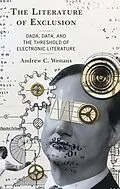In the early twentieth century, the Dadaists protested against art, nationalism, the individual subject, and technologized war. With their automatic anti-art and cultural disruptiveness, Dadaists sought to "signify no thing." Today, data also operates autonomously. However, rather than dismantling tradition, data organizes, selects, combines, quantifies, and simplifies the complexity of actuality. Like Dada, data also signifies nothing. While Dadaists protest with purpose, data proceeds without intention. The individual in the early twentieth century agonizes over the alienation from daily life and the fear of being converted into a cog in a machine. Today, however, the individual in twenty-first-century supermodernity merges, not with large industrial machinery, but with the processual and procedural logic of programming with innocuous ease. Both exclude human agency from self-narration but to differing degrees of abstraction. Examining the work of B.R. Yeager, Samuel Beckett, Jeff Noon, Kenji Siratori, Mike Bonsall, Allison Parrish, and narratives written by artificial intelligence, Wenaus considers the threshold of sensible narration and the effects that the shift from a culture of language to a culture of digital code has on lived experience. While data offers a closed system, Dadaist literature of exclusion, he suggests, promises a future of open, hyper-contingent, unprescribed alternatives for self-narration.
Autorentext
Andrew C. Wenaus is assistant professor in the department of English and writing studies at the University of Western Ontario.
Inhalt
Introduction: The Literature of Exclusion
Chapter 1: Metaphor and Metanoia: Linguistic Transfer, Cognitive Transformation, and Exclusion
Chapter 2: The Radical Poetics of Impersonality: The Posthuman, the Inhuman, and Dada
Chapter 3: The Divine Neutrality of the Apparatus: The Self-Reflexive Conceptual Horror of B.R. Yeager
Chapter 4: Something Is Taking Its Course: Zero-Player Games, Proceduralism, and Samuel Beckett's Endgame
Chapter 5: Blossoming Ghost: Memetic Engineering, Hauntology, and Metamorphiction in Jeff Noon's Falling Out of Cars
Chapter 6: Swarm Annihilation and Supermodern Transcendence: Chaotics, Granular Synthesis, and the Glitch Poetics of Kenji Siratori
Chapter 7: The Electronic Literature of Exclusion and Autopoiesis: Obsession and Fictionalism
Chapter 8: The Electronic Literature of Exclusion and Allopoiesis: Asemic Word Processing, Technical Images, and Allison Parrish's Ahe Thd Yearidy Ti Isa
Conclusion: Extro-Science Fiction, Hyper-Contingent Literatures of Exclusion, and Unthinkable Thought
